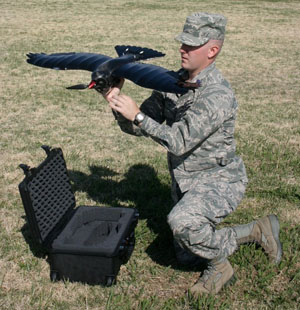
Caption
Provided / Design Intelligence Incorporated


Caption
Provided / Design Intelligence Incorporated
James Grimsley designs intelligent machines that mimic nature.
One of his projects looks like a bird. More importantly, it moves like one. The black, winged apparatus is programmed to fly, observe, perch, wait …
… and explode.
Drones are a booming business, and Oklahoma wants to pilot the controls.
Technological innovation often starts with government research. Drones are no different.
Development of UAVs — short for unmanned aerial vehicles, the industry’s less lethal-sounding term of choice — is growing in the United States and around the world.
Part of that growth is in the vehicles themselves — the self- or remotely piloted planes, helicopters, zeppelins and crafts. But there’s a lot of related business, including software, programming and communications equipment.
While Washington, D.C. lawmakers wrestle with reining in the U.S. defense budget, UAV research and development will likely be immune to cuts. In fact, Pentagon brass and the Obama administration have identified unmanned drones as a growing priority.
And drone technologies originally designed as war zone weaponry have a surprising array of non-military, civil and commercial uses, from pipeline inspection, data gathering and law enforcement to precision agriculture and storm tracking.
For drones to be successful, civilly and commercially, they have to safely navigate skies already occupied by airplanes. And they must safely fly above cities and communities.

Joe Wertz / StateImpact Oklahoma
James Grimsley, president and CEO of Design Intelligence Incorporated.
That will take a lot of testing, which is where Oklahoma fits in.
The Federal Aviation Administration is looking for six test ranges to test UAVs and related systems.
Oklahoma wants one of those test ranges to be created between the Clinton-Sherman Industrial Airpark — otherwise known as the Oklahoma Spaceport — and Fort Sill in Lawton.
One plus for Oklahoma is that its airspace is relatively uncluttered, says Grimsley, president and CEO of Norman’s Design Intelligence Incorporated, a defense contractor. Grimsley is also one of 13 Oklahomans Gov. Mary Fallin appointed to the Unmanned Aerial Systems Council.
Another plus, Grimsley says, is the Spaceport itself, which occupies a former Air Force base with a 13,000-foot runway,
“It’s an amazing asset,” he says. “Especially as part of a test range.”
The FAA is in the process of gathering public comments on the UAV test range plan, but agency spokesman Les Dorr says the timetable for picking the sites hasn’t been finalized.
Another plus for Oklahoma is the high level of cooperation between academics, businesses and the government, says Grimsley.
While interest in drones started at the grassroots level, Grimsley says lawmakers and state officials were quick to get on board. Fallin is a big UAV proponent, and has played an active role in trying to get getting manufacturers to move their operations to Oklahoma.
Fallin was the only governor who attended the Unmanned Vehicle Systems International convention in Washington, D.C. last year.
Oklahoma’s major universities are coordinating with small companies as well as each other, says Grimsley, who also serves as the Assistant Vice President for Research at the University of Oklahoma.
“We’re all working together, going in the same direction, all in agreement,” he says.
Drone technology is an extension of the aerospace industry, which has historical roots here in Oklahoma.
“Aerospace is a huge part of our economy,” Grimsley says.
The state Department of Commerce estimates that 147,000 Oklahomans work in the aerospace industry, which has an output estimated to be more than $11.7 billion annually.
In Oklahoma, much of the industry is focused on aircraft maintenance, repair and overhaul. The headlines there — with American Airlines in Tulsa and Boeing in Oklahoma City — haven’t been good. But Oklahoma thinks UAVs are an industry “bright spot” that will shine amid bankruptcies and shrinking defense budgets, Grimsley says.
If you want to test full-scale UAVs, you need restricted airspace.

John Moore / Getty Images
Academics and officials hope military drone technology evolves into commercial applications that can be researched, tested and manufactured here in Oklahoma.
Airspace is restricted around military installations. But Fort Sill, in Lawton, has a unique agreement with the Unmanned Systems Alliance of Oklahoma that gives researchers access to the restricted airspace.
OSU’s Multispectral Laboratory has an agreement with Fort Sill to use 200 square miles of its restricted airspace, which allows researchers to test and develop unmanned aircraft year-round.
The hope is that Oklahoma’s head start will help it secure an official FAA test site designation, and that defense contracts turn into commercial applications for drones that will be tested, developed and manufactured here in Oklahoma.
“This is a big business, a growing business,” says Stephen McKeever, Oklahoma State University’s vice president for research and technology and Fallin’s Cabinet secretary of science and technology.
UAVs are high-tech, and most of the companies involved are small, says McKeever, who likened drone development to the auto industry. Eventually small companies around the country coalesced to form an industry based largely in Michigan.
“If there’s going to be a coalescing, we would like it to happen in Oklahoma,” McKeever says.